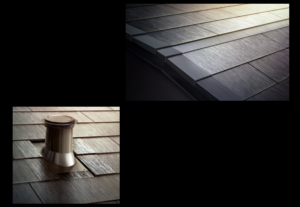

Elon Musk presented the products using the homes on Colonial Street set on the Universal Studios backlot. Shortly after the acquisition announcement, Tesla announced that it would be building a new version of the Powerwall and also introduced the Tesla Solar Roof, a solar shingle product. More than 85% of unaffiliated shareholders of Tesla and SolarCity voted to approve the acquisition on November 17, allowing the deal to close on November 21, 2016. The proposal for acquisition was approved by antitrust regulators in August 2016. The announcement of the deal resulted in a more than 10% drop in Tesla's stock price. The announcement cited (as benefits of the acquisition) operational and cost synergies, as well as allowing for integrated sales of products from Tesla's existing battery energy storage products division. Musk said the purchase would advance Tesla's mission by helping the world move from a mine-and-burn hydrocarbon economy towards a solar electric economy. Tesla's mission since its inception has been "to accelerate the world's transition to sustainable energy". On August 1, 2016, Tesla announced that it would be acquiring SolarCity in an all-stock $2.6 billion acquisition. īy 2016, SolarCity had installed solar energy systems for over 325,000 customers and was one of the largest solar installation companies in the United States. In June 2014, SolarCity committed to building a second factory, later called Giga New York, in Buffalo, New York, that would build photovoltaic cells and would be triple the size of the next largest photovoltaic manufacturing plant in the United States. Musk suggested the solar company idea to the Rive brothers and he later served as the chairman of SolarCity.
#Tesla roof tiles ct install
Tesla buys SolarCity īrothers Peter and Lyndon Rive, the cousins of Tesla CEO Elon Musk, founded SolarCity in 2006 to sell and install solar energy generation systems as well as other related products and services to residential, commercial and industrial customers. This battery technology is not an innovation of what is available in the market but, according to Musk, the company offered a product that is easy to install, more attractive, less expensive and can also be easily maintained. The Giga Nevada factory started limited production of Powerwalls and Powerpacks in the first quarter of 2016 using battery cells produced elsewhere, and began mass production of cells in January 2017. Five hundred pilot units were built at the Tesla Fremont Factory and installed during 2015. The Tesla Energy brand was introduced on April 30, 2015, as CEO Elon Musk announced that the company would apply its battery technology to a home energy storage system called the Powerwall. In November 2013, Tesla announced that it would build Giga Nevada, a factory to produce lithium-ion batteries. Starting in 2012, Tesla installed prototype battery packs (later called the Powerpack) at the locations of a few industrial customers. developed batteries for its electric car business, the company also started experimenting with using batteries for energy storage. History Tesla's expansion into battery energy storage Īs Tesla, Inc. The division generated $3.91 billion in revenue for the company in 2022, a 40% increase over 2021. In 2022, the company deployed solar energy systems capable of generating 348 megawatts (MW), an increase of 1% over 2021, and deployed 6.54 gigawatt-hours (GWh) of battery energy storage products, an increase of 62% over 2021.
#Tesla roof tiles ct software
Additionally, Tesla develops software to support its energy products. The company also makes large-scale energy storage systems called the Powerpack and Megapack. The company's current power generation products include solar panels (manufactured by other companies for Tesla), the Tesla Solar Roof (a solar shingle system), and the Tesla Solar Inverter. This deal was controversial at the time of the acquisition, SolarCity was facing liquidity issues. In November 2016, Tesla acquired SolarCity, in a US$2.6 billion deal, and added solar energy generation to Tesla Energy's business.


The division was founded on April 30, 2015, when Tesla CEO Elon Musk announced that the company would apply the battery technology it developed for electric cars to a home energy storage system called the Powerwall. that develops, manufactures, sells and installs photovoltaic solar energy generation systems, battery energy storage products and other related products and services to residential, commercial and industrial customers. is the clean energy division of Tesla, Inc.


 0 kommentar(er)
0 kommentar(er)
